Finally a good
quality, accurate 1/72-scale Flugabwehrkanone 36 (Flak 36) gun in
plastic. For years we Braille Scalers had to live with the 1980’s
era Hasegawa kits of the 88-mm Flak 18 (kit
#31110 MT10) and Flak 36 (kit #31138 MT38 - reviews here
and here) which, while
great for their day, are simple wargaming kits to me these days. The
Hasegawa Flak 36 kit is not even a representation of a real Flak 36,
but a Flak 36 barrel on a Flak 18 carriage, mount and trailer.
This review will describe what is supposed to be in the box, what
Revell actually puts in the box, and reference photos to help us build
an accurate Flak 36 gun.
Revell’s box art looks great and shows a Flak 36 in either an
anti aircraft roll firing at low flying P-47 Jabos or being attacked
while the gun is being used against ground targets. Seeing that the seated gunner is looking through the direct fire gunsight he has to be firing at ground targets. I like the art
quality and it is great inspiration for depicting the gun in action
and for a diorama. Based on the aircraft and crew uniforms this appears
to be set on the Western Front in 1944 or 1945; the vegetation implies
late spring-summer to me but the uniforms implies a cool late autumn
or winter.
Only two crew members are shown manning the gun but in reality the
gun would have five or more (up to nine). If I were being strafed
by Jabos I would not be so relaxed as these gentlemen are.
The gun is painted in a dark panzer gray (Dunkelgrau) typical of a
gun made prior to 1943, but this color could still be seen up to the
war’s end. It appears to have splotches of panzer yellow (Dunkelgelb)
camouflage on the shield. Though depicted here, the model kit does
not contain any 88-mm rounds or crew figures. At the ends of the cruciform
legs after the rectangular ground pads I note stakes driven into the
ground to assist in stabilizing the gun during firing.
At far right there is what appears to be one of the two Sonderanhanger
202 (Sd.Ah. 202) trailers a.k.a. bogies) needed to tow the Flak 36;
there would be one of these trailers at each end of the gun and they
are almost identical. (The fore and aft Sd. Ah. 201 trailers used
on the 88-mm Flak 18 gun were rather different from each other, one
being for the front and the other being only for the rear.) The Sd.Ah.
202 trailers have spools of cables which I’ve read are data
communication cables (I think to the gun director). The gun and trailers
would be towed by an SdKfz 6 5-ton or a SdKfz 7 8-ton halftrack tractor.
The Kommandogerat 40 gun director (a kind of rangefinder, command
device and predictor) is at far left and I think it would not be used
during direct firing at ground targets. The gun director directs more
than one weapon and would be served by five crewmembers, not one as
shown here in the box art. The director and Sd.Ah. 52 trailer I believe
would be towed by 1.5 or a 3-ton truck.
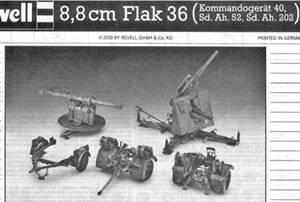
This photo of the assembled model
is from Revell’s instruction sheet and can be seen in color
at Revell’s website. At the upper right is the Flak 36 with
the shield in firing position. In the right foreground are the two
Sd.Ah. 202 trailers. Notice that the right one has a seat for a crew
member, the left Sd.Ah. 202 trailer has the towing tongue. At far
left is the Kommandogerat 40 gun director and its Sd.Ah. 52 trailer.
Overall I counted about 167 pale-gray colored, injection molded styrene
plastic parts for the gun and Sd.Ah. 202 trailers on four sprues.
There are about 31 parts for the gun predictor and Sd.Ah. 52 trailer
on Sprue-C.
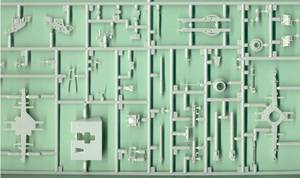
Sprue-A mostly includes the gun, cradle
and carriage parts. Parts are delicate, well molded and detailed.
There are a few small sinkholes and an occasional part with some molding
flash. At the top left and bottom left are the base parts of the cruciform
base with one of two gun shield below it. This gun shield (part-60)
is wider than the other shield, part-57. The shield is a little thick
and an etched brass replacement would be wonderful. At the center
left are two gun barrels: part-20 for the Flak 36 and part 51 which
I think is a Flak 18 gun barrel (which implies to me that there is
a Flak 18 barrel variant kit release in the future? Both gun barrels
will need to have the muzzles drilled out. At the right are the gun
carriage and cradle parts with lots of separate parts consisting of
the gages, crew seats, and the elevation and traverse handwheels,
etc. Parts-53 and 54 are for a direct fire gun sight, such as for firing at tanks; something not included in the Hasegawa 88-mm Flak models.
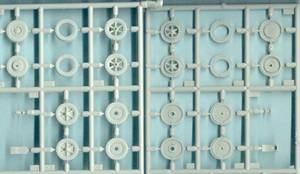
This is a scan of the trailer wheels
on the two Sprue-B’s. The wheels are molded in two parts which
will help in molding a more accurate tread pattern and so the tires
are not so thick that sink holes will form. [Modell Trans Modellbau
makes resin replacement Sd.Ah 202 & Sd.Ah. 52 wheels (#MT72365)
for the for Revell 8.8-cm Flak 36 kit.]
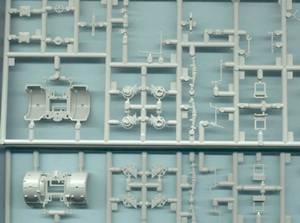
Another section of the two B sprues
has the Sd.Ah. trailers. In the center are the parts for the cable
spools. Parts are well done and some are rather delicate; take great
care when cutting them off the sprue.
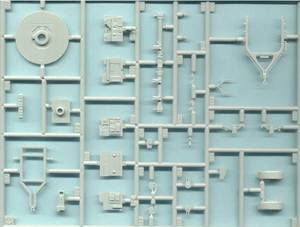
Above is Sprue-C with parts for the
Kommandogerat 40 gun director and its Sd.Ah. 52 trailer. At the upper
right is the nicely detailed trailer frame, at the lower left is the
frame base for the gun director. In the center are the four sides
and top of the gun director.
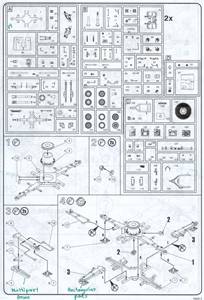
Here is the first page of the assembly
instructions showing the parts diagram for four sprues with parts
numbers (take note that there are two Sprue-Bs). The cruciform base
contains many parts and is well detailed.

Skipping to step 16 in the instructions
we see a choice in the two gun shields that come with the model, parts
57 and 60, then assembly into the firing or travel positions. We’ll
have to do homework to find out which shield is appropriate for what
time period, unit and location. The ground stakes (parts-8) are a
nice touch that Hasegawa leaves out.
The instructions show us the assembly of the weapon in towing mode
or in firing mode. Now if we only had about nine really good quality
crew figures to go with this, German or even Italian.
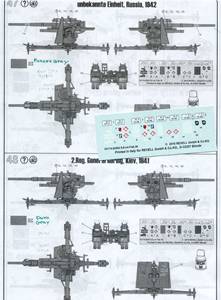
From Revell’s instructions,
here are two out of the four black & white diagrams of the gun
in firing position with locations for the water slide decal markings
included in the model kit (at the center right). The markings typically
include license plates on the trailers, an alphabetic gun designation
on the recuperator cylinder, kill rings on the gun barrel or kill
markings on the shield.
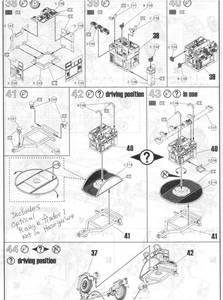
Assembly of the Kommandogerat 40 gun
director and its Sd.Ah. 52 trailer goes from steps 38 to 44. I am
impressed by the detail; I am even more impressed that Revell included
this piece in the kit. I understand that one of these would control
four flak guns.
This 88-mm Flak 36 model appears to
have accurate features, is well molded and is well detailed. I find
it a very welcome addition. This Revell AG model should make a great
display model. For wargaming I would still stick with the simpler,
more robust and less expensive Hasegawa kits or new Italeri 88-mm
Flak kit. In addition to good crew figures we also need a good SdKfz
7 towing tractor to replace Hasegawa’s old offering.
Modeling References:
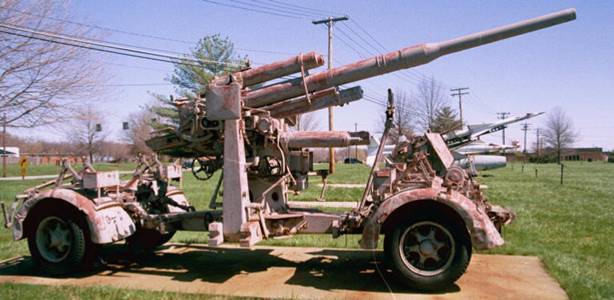
1. A true 88-mm Flak 36 gun, carriage and mirror-image Sd.Ah. 202
trailers fore and aft, forward & rear legs and square ground pads.
Notice the collar midway down the barrel (part-20 in the Revell model);
I understand this is where the Flak 36 barrel separates into its three
components. There are some parts missing, such as the gun shield and
cable spools on the trailers. Note similarities in firing controls
in this and the Flak 36 in Photo 2 below. We have to keep in mind
that it is was not the gun barrel that defines a Flak 36 from a
Flak 18, but the gun controls, cruciform platform and trailers!
The Flak 36 three-part barrel would fit on a Flak 18 cradle and vice
versa. (This photo and photos below are by Stephen Brezinski, from
Aberdeen Proving Grounds, Maryland, USA. No copyright, feel free to
save and print them.)
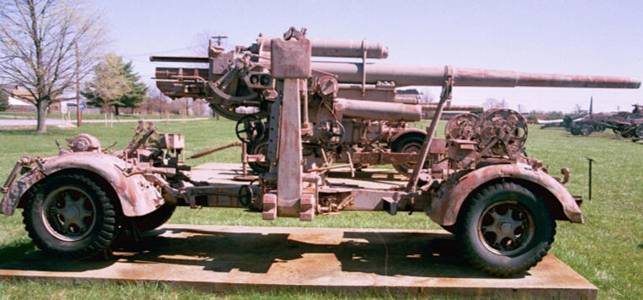
2. Flak 36’s carriage
and trailers with Flak 18 barrel. The Flak 18 barrel gently tapers
back to the breach unlike the Flak 36 barrel in Photo-1. Note similar
firing controls, square ground pads on the side outrigger, almost
mirror-image fore and aft Sd.Ah. 202 trailers. Except for some missing
parts and the Flak 18 barrel this weapon looks like the one in Photo-1
above. Unlike the Sd.Ah. 201 trailers, this Flak 36 weapon and trailers
could be towed from either end. Like the gun in Photo-1 above, this
gun also has no shield.
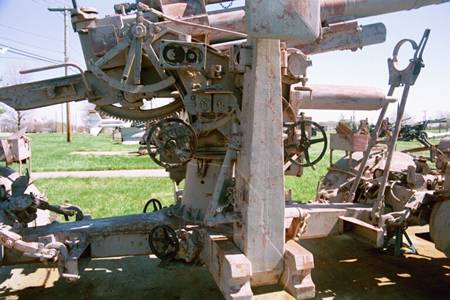
3. True Flak 36 cruciform mount
with matching Sd.Ah. 202 trailers fore and aft. The hand wheels at
the base between the outriggers are the cross-leveling handwheel.
Notice the travel barrel-support (muzzle rest) at the right. Fore
and aft on the cruciform base (lower left and right) are U-channel
beams with hooks for attaching to the trailers. On the carriage are
the aiming handwheels and dials. The protractor-like device at the
upper left is the elevation quadrant and pointer. In center foreground
is an outrigger folded up for travel with the square baseplate characteristic
of the Flak 36. Notice the casting-seam or weld mark running vertically
up the outrigger; if this were a model this seam would cost a model
points at a contest!
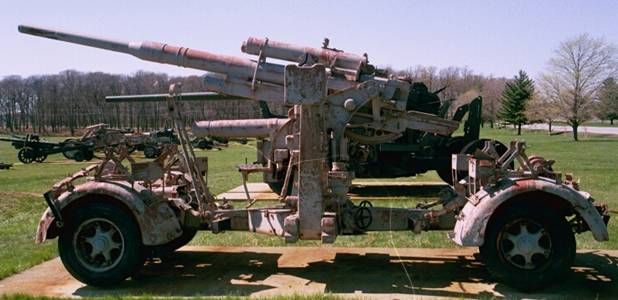
4. The left side of the Flak
36 all folded up for travel. Some items like the stakes are missing.
The white paint over the red primer is not original but the result
of 60+ years at Aberdeen Proving grounds with lack of funding to properly
preserve the displays here.
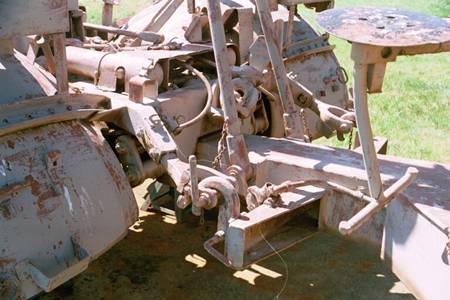
5. Trailer coupling unit and
Flak 36’s Sd.Ah. 202 trailer (a.k.a. bogies) of the Flak 36.
The towing bar could be attached to either trailer so there was technically
no front and back of the gun. In comparing this with the Flak 18’s
Sd.Ah. 201 trailers we can see why the trailers are not interchangeable
between the Flak 18 and Flak 36.
Other references:
- I. The German 88 Gun In Combat,
by Janus Piekalkiewicz. Schiffer Military Publishing (1992) A hardcover
book focusing on the Flak gun’s AT and ground use with many
black & white photos and English text.
- Photos of the three guns at Aberdeen
Proving Ground. [I have noted so many slight variations in details
of the actual guns in photos that I would not worry if something
wasn’t exactly as one photo or expert claims it is.]
- German Artillery of World war Two,
by Ian V. Hogg. From Greenhill Books and Stackpole Books (1997).
- Anti Aircraft Artillery, by Ian
V. Hogg.
- U. S. War Department Technical Manual
TM E9-369A, German 88-mm Antiaircraft Gun Materiel, dated 29 June
1943.
- http://www.revell.com/germany/military/80-3174.html
Revell-Monogram website with information on the kit.
- http://www.model-making.eu/revell-3174-german-anti-aircraft-gun-8-8-cm-flak-36-fire-director-40-sd-ah-202-amp-52--p-1-1878628.html
- http://www.achtungpanzer.com/88mm-flak-series-flugabwehrkanone.htm
George Parada’s Achtung Panzer website there is an excellent
section on the Flak 88 with photos of a restored Flak 36 and Sd.Ah.
202 trailer
- http://commons.wikimedia.org/wiki/88_mm_gun
- http://www.britmodeller.com/forums/index.php?showtopic=56870
This site has scans of the full Revell kit sprues. (The site
appears to be down.)
Editor's note.
Scans of the manual and sprues can also be found on the Henk
of Holland website, while a fine walkaround can be found on the Prime Portal.
|